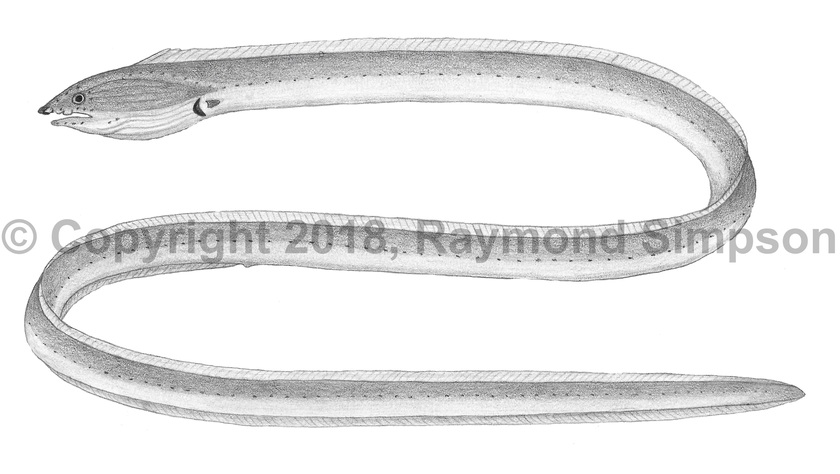
Common Name
Unexpected Eel
Year Described
McCosker, Böhlke & Böhlke, 1989
Identification
Vertebrae: 199 (101 pre-anal)
Supraorbital pores: 1+4
Body extremely elongate and cylindrical in cross-section. Trunk length a little longer than tail (52-57%). Snout pointed and overhangs jaw. Underside of snout flattened with a toothed (3 teeth) median groove reaching anterior nostril. Anterior nostril tubular on underside of snout. Posterior nostril opens in mouth. Eye small over rear third of jaw. Jaw downturned and small. Teeth small and uniserial in both jaws. Vomerine teeth in two rows. Intermaxillary teeth present. Head pores well developed. Gill pouches and cheeks strongly grooved. Gill openings low on body and strongly converging anteriorly. Dorsal and anal fins present but low. Dorsal fin begins on top of head. Pectoral fin small (base 36-37% length of gill opening), triangular, and low on body. Caudal fin absent. Tail tip hard and pointed. Lateral line complete.
Color
Body strongly bicolored dark brown and cream, with a sharp demarcation along lateral line. Pores noticeably lighter posteriorly. Gill opening dark. Head also bicolored with a few random white blotches. Dorsal fin white with a thin dark edge rearward.
Size
Maximum size to 81.3cm TL.
Habitat
Shallow sandy bottoms from 1-40m.
Range
Puerto Rico and possibly Panama.
References
Böhlke, E. B. (ed.). 1989. Volume One: Orders Anguilliformes and Saccopharyngiformes. Volume Two: Leptocephali. Fishes of the western North Atlantic. Memoirs of the Sears Foundation of Marine Research Mem. 1 (part 9): v. 1:i-xvii + 1-655; 2:i-vii + 657-1055.
Moreno, F., A. Acero P, & M. Grijalba-Bendeck. 2016. A new species of sand eel genus Bascanichthys (Anguilliformes: Ophichthidae) from the Caribbean. Boletín de Investigaciones Marinas y Costeras-INVEMAR, 45(1), 7-14.
Other Notes
The only Bascanichthys from an insular locality in the Caribbean, and also the only Atlantic species with a supraocular pore count of 1+4 and the highest vertebral count.